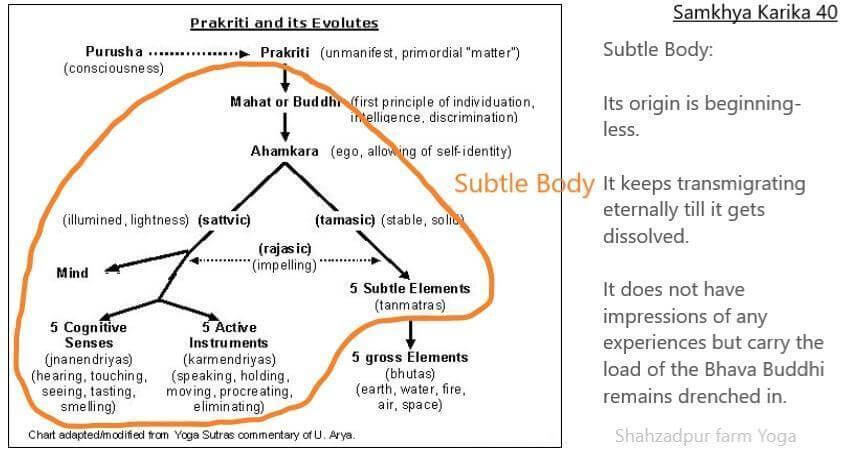Author: Randeep Singh / go to all Samkhya Karikas

Samkhya Karika 40 text:
Purva-utpannam asaktam niyatam mahat-adi sukshma paryantam I
Samsarati nirup-bhogam bhaavaihi adhivaasitam lingam II
Purva-utoannam – primeval, beginning-less
Asaktam – unconnected, unconfined
Niyatam – contant, eternal
Maha-adi sukshma – from Mahat upto Tanmatras
Paryantam – composed of
Samsarati – transmigrates
Nirup-bhogam – free from experiences
Bhaavaihi – bhavas, dispositions
Adhivaasitam – colored, tinged, affected
Lingam – unified, merged, subtle body that has merged
Samkhya Karika 40 describes the origin and nature of the subtle body. This Sankhya Karika text discusses the nature of subtle body only with reference to living entities (humans) and not about the phenomenological world.
Samkhya karika 40, What Comprises the Subtle Body?
The concomitant cause of the human being is the uniting (milan) of the sperm (bindu) and the ovum (raja). It is further known that there is a subtle or inner body by the side of our gross body. Both of these are inter-related; the physical or corporeal body only being a limit – a sort of circumscription – to the mental or subtle body.
Of these two bodies, the first is known as physical body (drasya sarira) – the external structure of bones, muscles, tissues, nerves etc. representing all that is physical as well as all that is visible in human body. This visible mechanism is usually called the human body by the physiologists and may be studied with the help of anatomy and other allied sciences.
The inner body is however composed of a invisible structure of subtle infra-atomic particles with which are associated all vibrations of thought, feeling, emotion etc. This constitutes eighteen elements beginning from Mahat (intelligence) to Tanmatras (subtle elements).
These are:
Buddhi, Ahamkara, Manas (mind), five cognitive senses of vision, touch, smell, taste, and hearing, five conative senses of speech, handling, foot movement, the ejective sense and the generative sense, and five potential or subtle elements known as Tanmatras.
The work of this body ( a complex combination of potentials and reals) involves analysis of knowledge and the root exchange of all causal activities.
Nature of the Subtle Body and its Transmigration
As per Samkhya philosophy subtle body (bodies) was created in the primeval era when the evolution of the universe from the Mula Prakriti had begin. They were created before the material world existed, as Mahabhutas comes next int he sequence of evolution. This Sankhya Karika touches upon the eternal question on how were the humans created and the theory of re-birth.
It says that it is the gross body which dies, or perishes, the subtle body doesn’t perish, rather it eternally keeps transmigrating to the next gross body. One subtle body is created for one Purusha. It is so subtle that no empirical methods devised by human mind can ever perceive it. It keeps adorning a new gross body when the last one perishes.
This explains the theory of re-birth of humans, The subtle or mental body keeps moving from one life (span of a gross body) to another. They can keep transmigrating endlessly through time, the only thing they carry with them is the Bhava the associated Buddhi (intellect) is immersed in. Suppose the Buddhi part of a subtle body has Sattvik bhava as its disposition, This bhava gets transmigrated to the next life (gross body) along with the subtle body.
Subtle body is free from experience, which means that the experiences generated by the Buddhi of the Subtle body while being inside a particular gross body do not get transmigrated to the next gross body along with it.
The Bhava or the disposition a particular Buddhi has determines the personality of the subtle body and the subsequent individual it forms a part of. That is why two siblings born of same parents have different personalities. In fact, the personality of every being in this world differs from each other. The disposition (bhava) of the individual Buddhi produces the associated personality traits within the individual.
Thus, this karika helps us realize the significance of Buddhi and its inherent nature. One must understand this fact and strive for transforming Buddhi towards Sattvik Bhava. Then only liberation of the subtle body is possible. One needs to understand the concept of subtle body and work towards liberating it from the clutches of karma which keeps it bound to the material universe and is the reason for its transmigration from one live to another.
The purpose of Sankhya Darshan is to provide the seeker with the knowledge of Prakriti and Purusha. One has to realize that the subtle body and the material (gross elements) world id Prakriti and is every changing. It is only Purusha which is stable, steady and just an observer of the play of Prakriti.
It is like knowing the parts of a vehicle well so that we can steer it to our destination without any problems on the way. It is important to know the parts (evolutes of Prakriti) our existence, gross and subtle bodies, is made up of.
Only then we would know what needs to be pursued, and how. Most important, Samkhya tells us what does not need to be pursued in order to direct all our efforts towards the main goal of ultimately realizing the real consciousness, the Purusha.
